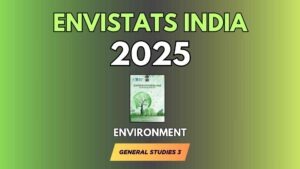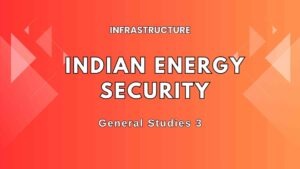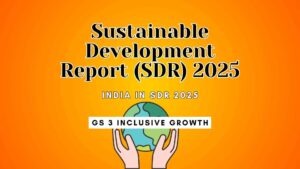Indian Energy Security- Important UPSC Notes
Indian Energy Security
🧭 In News
In 2025, India became the 4th largest economy in the world with a GDP of $4.3 trillion.
The Union Petroleum Minister recently discussed India’s energy strategy, including:
Biofuel achievements
Green hydrogen development
And overall energy security roadmap
⚡ What is Energy Security?
Energy Security means ensuring:
Reliable access to energy (no frequent shortages)
Affordable prices (not overburdening citizens or industries)
Sustainable supply (not harming the environment)
🔥 Why Does India Need Energy Security?
Rapid Growth in Demand
India is expected to account for 25% of the global energy demand by 2047.
Rising population, urbanisation, and economic development fuel this demand.
Strategic Autonomy
India heavily depends on imports for oil and gas, which makes it vulnerable to:
Geopolitical tensions (like wars or trade restrictions)
Fluctuating global oil prices
Reducing this dependency enhances national security.
Support for Economic Growth
India’s GDP growth rate (6.7% in Q1 2025) requires uninterrupted energy supply to:
Run industries
Build infrastructure
Deliver public services
Equitable Development
Ensures both urban and rural areas get access to modern energy:
City gas distribution in urban centers
LPG access in rural areas (e.g., Ujjwala scheme)
Climate Goals
India has pledged to achieve Net Zero emissions by 2070 under its INDCs (Intended Nationally Determined Contributions).
This requires moving away from fossil fuels to renewable and clean energy sources.
🧭 India’s Multi-Pronged Energy Strategy
To ensure energy security, India is pursuing a diverse and integrated energy policy:
Source Diversification
Reducing over-reliance on a few countries for oil/gas imports.
Expanding domestic production of fossil fuels and encouraging investment.
Exploration Reforms
Policies like Open Acreage Licensing Policy (OALP) and Discovered Small Fields (DSF) reform.
Result: India’s exploration area doubled from 8% in 2021 to 16% in 2025, with a target of 1 million sq km by 2030.
Pricing Reforms
Linking gas prices to Indian crude basket to make it more competitive.
New exploration wells get a 20% price premium, encouraging private investment.
Infrastructure Growth
India has built:
24,000 km of petroleum product pipelines
96,000+ fuel stations
ONGC and Oil India added 75 million metric tonnes of oil equivalent (MMtoe) through new discoveries.
Digital Governance
Through PM Gati Shakti, over 1 lakh energy infrastructure assets were digitally mapped.
Led to better coordination and ₹169 crore cost savings by optimizing energy routes.
🌱 India’s Push for Green Energy
India is also shifting toward clean and renewable energy to meet climate goals:
Ethanol Blending
Increased from 1.5% in 2013 to 19.7% in 2025.
Result:
Saved ₹1.26 lakh crore in foreign exchange (reduced crude imports).
Provided ₹1.79 lakh crore to sugarcane farmers and distilleries.
Green Hydrogen Mission
India tendered 8.62 lakh tonnes of green hydrogen.
Notable projects:
IOCL’s 10 KTPA green hydrogen plant at Panipat
NRL (Numaligarh Refinery) to pioneer hydrogen energy in the North-East region
Compressed Biogas (CBG)
Over 100 CBG plants under the SATAT initiative.
Targets 5% blending by 2028.
Benefits:
Uses agricultural waste productively
Promotes circular economy
National Gas Grid Expansion
Current pipeline network: 25,000 km
Target: 33,000 km by 2030
Hybrid Energy Leasing (2024 Amendment)
Oilfields can now host both fossil fuel and renewable energy projects.
Encourages low-carbon transition without halting current energy production.
✅ Conclusion
India has evolved from an energy-deficient nation to one that is increasingly self-assured.
With a combination of:
Diversified sources,
Strong infrastructure,
Digital reforms,
And a green energy shift,
India is creating a resilient, inclusive, and climate-friendly energy ecosystem aligned with both development and global climate commitments.
🔍 Additional UPSC-Relevant Concepts (Explained)
Net Zero: A state in which the amount of greenhouse gases emitted is balanced by the amount removed from the atmosphere.
INDC: Voluntary commitments made by countries to reduce emissions under the Paris Climate Agreement.
MMtoe: Million Metric Tonnes of Oil Equivalent, a unit to measure large-scale energy.
Mains-Based Questions on Indian Energy Security
Question 1:
India’s journey from energy anxiety to energy self-assurance reflects a strategic shift in policy. Discuss the key pillars of India’s energy security strategy in this regard. (15 marks, 250 words)
Model Answer Framework:
Introduction:
Energy security is a critical component of India’s national development and strategic autonomy.
As India becomes the 4th largest economy (2025), its shift from energy dependency to diversified, sustainable energy reflects a mature and multi-pronged energy policy.
Body:
1. Need for Energy Security:
Growing energy demand: India to account for 25% of global demand by 2047.
Strategic independence from volatile global markets.
Inclusive development and climate commitments (Net Zero by 2070).
2. Key Pillars of India’s Energy Strategy:
Diversification of Sources:
Expanding import base and domestic production.
Exploration and Production Reforms:
OALP and DSF increased coverage to 16%, targeting 1 million sq. km.
Pricing and Investment Incentives:
20% premium for new wells; gas pricing linked to crude basket.
Infrastructure Expansion:
24,000 km product pipelines; 96,000+ fuel outlets; 75 MMtoe new reserves.
Digital Governance:
PM Gati Shakti: ₹169 crore savings through optimization of 1 lakh+ energy assets.
3. Green Energy Focus:
Biofuel success: Ethanol blending rose to 19.7%, saved ₹1.26 lakh crore in forex.
Green Hydrogen: Tendered 8.62 lakh tonnes; Panipat plant, NE initiatives.
Compressed Biogas: 100+ plants under SATAT.
Hybrid Leases: Integrates fossil and renewable energy fields.
Conclusion:
India’s strategic shift in energy policy ensures energy security, economic growth, and environmental sustainability.
With sustained reforms, India is well on its way to becoming a global energy leader aligned with development and climate goals.
Question 2:
What role does green energy play in ensuring India’s long-term energy security? Critically evaluate India’s performance in this domain. (10 marks, 150 words)
Model Answer Framework:
Introduction:
Green energy is essential for achieving energy independence and meeting climate commitments like Net Zero by 2070.
It reduces dependence on fossil fuel imports and promotes sustainable economic development.
Body:
1. Green Energy in Energy Security:
Reduces fossil fuel import bill.
Supports rural economy (biofuels, biogas).
Encourages innovation and private investment.
Aligns with global climate commitments (Paris Agreement, INDCs).
2. India’s Performance:
Ethanol blending: Rose from 1.5% (2013) to 19.7% (2025); saved ₹1.26 lakh crore in forex.
Green hydrogen: Major tenders; Panipat project by IOCL.
SATAT CBG initiative: Over 100 plants, target 5% blending by 2028.
Hybrid leases: Combines hydrocarbons and renewables to accelerate transition.
3. Challenges:
Infrastructure gaps (e.g., pipeline connectivity).
Technological and financial barriers in green hydrogen.
Skewed regional access and slow private sector uptake in some sectors.
Conclusion:
Green energy is not just a climate necessity but a cornerstone of India’s energy sovereignty.
While progress is commendable, sustained policy support and innovation are key to scaling up efforts.
Question 3:
“Energy access and equity are as important as energy availability in ensuring energy security in India.” Analyze. (10 marks, 150 words)
Model Answer Framework:
Introduction:
Energy security encompasses not only supply availability but also affordability and accessibility across socio-economic and geographic groups.
Body:
1. Importance of Access and Equity:
Inclusive energy access ensures:
Rural development (e.g., LPG under Ujjwala Yojana).
Reduction of energy poverty.
Gender empowerment through clean cooking fuels.
2. Current Initiatives Promoting Equity:
City Gas Distribution networks in urban areas.
LPG penetration in rural areas.
PM Gati Shakti optimizing energy assets for all regions.
Digital infrastructure helps monitor and target underserved regions.
3. Remaining Challenges:
Energy access disparities across North-East and tribal belts.
Affordability of new green energy technologies for poor households.
Infrastructure still lags in hilly and remote areas.
Conclusion:
Equitable energy access is crucial for sustainable development.
India must ensure that energy reforms bridge regional and socio-economic divides, aligning growth with justice.
Prelims Questions based on Indian Energy Security
-
Stampede Management in India – Important UPSC Notes
A stampede occurred at Chinnaswamy Stadium, Bengaluru, during RCB’s IPL... -
EnviStats India 2025 – Important UPSC Notes
The 8th edition of EnviStats India 2025 was released by... -
Quantum Computing – Important UPSC Notes
Tech giants like Google, IBM, and China’s Jiuzhang have developed... -
Indian Energy Security – Important UPSC Notes
In 2025, India became the 4th largest economy in the... -
Indian Food and Fertiliser Subsidies – Important UPSC Notes
With poverty down to 5.3%, distributing food subsidies to 800... -
India in SDR 2025 – Important UPSC Notes
India in SDR 2025 has ranked 99th, entering the Top... -
Indian FDI Mystery- Important UPSC Notes
India received a 13.7% increase in total FDI (Gross FDI...








